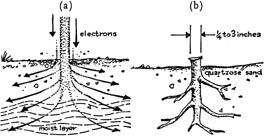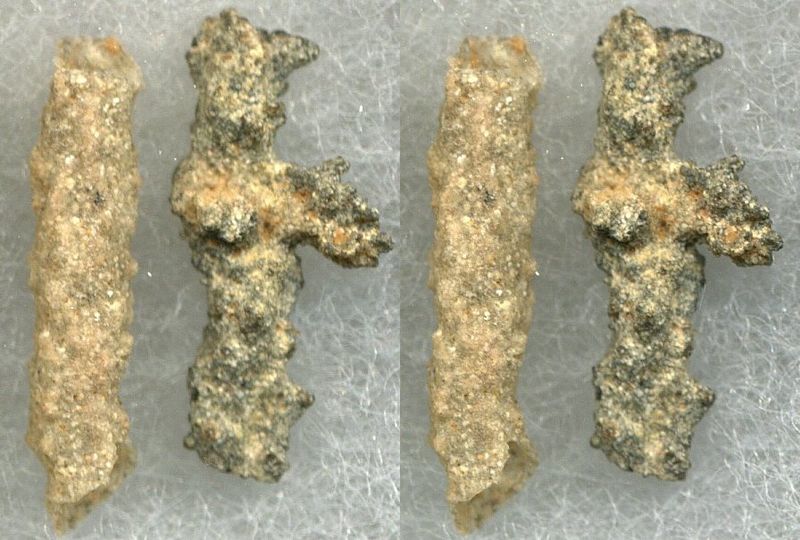Stereoscopic picture a small tube fulgurite and a more irregular one. From Wikipedia (emphasis added):
Fulgurites (from the Latin fulgur, meaning “lightning”) are a variety of the mineraloid lechatelierite. They are natural hollow glass tubes often formed during lightning strikes, in quartzose sand, silica, or soil. Sometimes they are referred to as petrified lightning. Fulgurites may be instances of Lichtenberg figures, which are branching patterns formed by high-voltage discharges such as lightning.
(…) Fulgurites occasionally form as glazed tracks on rock, or as networks completely metamorphosing the target rock.

a) When lightning strikes the earth, electrons flow outward in all directions. (b) Petrified lightning or fulgurite is sometimes made when lightning strikes and fuses certain types of sand. When formed on beaches or shores, a fulgurite is usually covered with shifting sand and goes undiscovered. Eroding sand may expose a fulgurite.
(Diagram by Read Viemeister)
-
![[PDF]](https://www.eixdelmon.com/wp-content/plugins/papercite/img/pdf.png) P. E. Viemeister, “Petrified Lightning,” , 1983.
P. E. Viemeister, “Petrified Lightning,” , 1983.
[Bibtex]@Booklet{viemeister1983, Title = {Petrified Lightning}, Author = {Peter E. Viemeister}, HowPublished = {Contemporary Art Museum, University of South Florida}, Note = {Supplemental didactic material for the event "Petrified Lighning fromCentral Florida", a project by Allan McCollum}, Year = {1983}, Abstract = {If lightning strikes sand of the proper composition, the high temperature of the stroke may fuse the sand and convert it to silica glass. “Petrified lightning” is a permanent record of the path of lightning in earth, and is called a fulgurite, after fulgur, the Latin word for lightning. Fulgurites are hollow, glass-lined tubes with sand adhering to the outside. Although easily produced in the laboratory in an electric furnace, silica glass is very rare in nature. The glass lining of a fulgurite is naturally produced silica glass, formed from the fusion of quartzose sand at a temperature of about 1800° centigrade.}, Owner = {trismegisto}, Timestamp = {2015.12.07} }
More stereoscopic images fulgurites can be found here.







